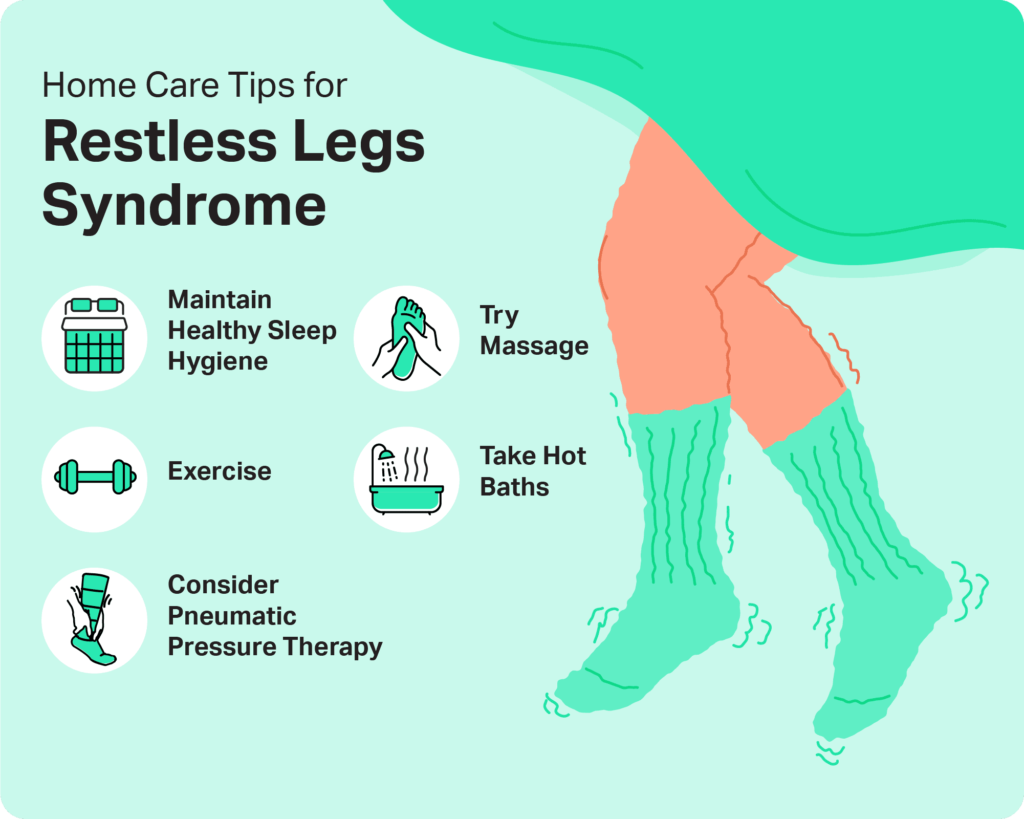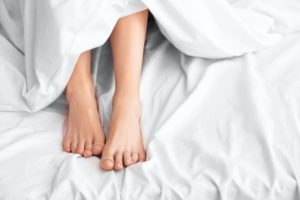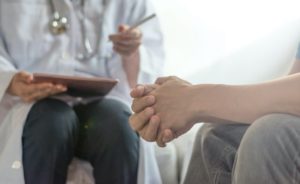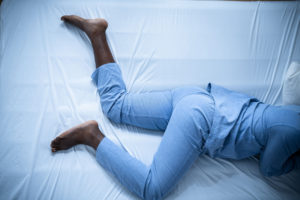Restless Legs Syndrome (RLS)
What it is, its causes and symptoms, and how it can be addressed to improve sleep
- Restless legs syndrome causes uncomfortable sensations in the legs which can create an overwhelming urge to move them.
- Symptoms like itching, prickling, pulling, or crawling tend to worsen when relaxing or lying down and often disrupt sleep.
- While sometimes associated with other medical conditions, the cause of most cases of restless legs syndrome is unknown.
Restless legs syndrome (RLS), also called Willis -Ekbom disease, causes uncomfortable feelings in the legs, such as itching, prickling, pulling, or crawling. These sensations create an overwhelming urge to move the legs.
People with RLS may walk, stretch, or shake their legs to achieve relief. However, this relief is temporary and the bothersome sensations usually return once the person goes back to resting. Symptoms tend to be worse in the evening and when inactive, including when relaxing or lying down. As a result, the symptoms of RLS often disrupt sleep.
RLS affects 5 to 10% of adults and 2 to 4% of children in the U.S. and it is found in women more often than men. People of all ages can develop RLS, but the most severe symptoms tend to occur in pregnant people and older adults.
What Are the Symptoms of Restless Legs Syndrome?
The sensations associated with RLS typically are not described as painful, both bothersome or distracting. This makes them difficult to characterize. The words and phrases most commonly used by people with RLS to describe the feelings are:
- “Twitchy”
- “Uncomfortable”
- “Restless”
- “Need to stretch”
- “Urge to move”
Is Your Troubled Sleep a Health Risk?
A variety of issues can cause problems sleeping. Answer three questions to understand if it’s a concern you should worry about.
Restless Legs Syndrome and Insomnia
The urge to move one’s legs makes falling asleep difficult for many people with RLS. A study found that 88% of individuals with RLS reported at least one sleep-related symptom. RLS symptoms often appear shortly after lying down at night and some people with RLS are compelled to get out of bed and kick, stretch, or massage their legs.
As a result of the sleep disturbances associated with RLS, individuals often experience fatigue and daytime sleepiness. Sleep deficiency (reduced sleep quantity and sleep quality) is often associated with RLS, as well as depression, anxiety, heart disease, and obesity. Concerns about sleep and evening discomfort are the main reason people with RLS seek medical care for their condition.
Restless Legs Syndrome and Periodic Limb Movement Disorder
Most people who have RLS also have a condition called periodic limb movement disorder (PLMD). PLMD involves repetitive flexing or twitching of the lower limbs that, because they occur during sleep, people are often not aware of them.
PLMD differs from RLS in that movements occur during sleep and are not accompanied by uncomfortable sensations. However, PLMD-associated movements can cause a person to wake up and therefore can compound sleep issues in patients who also have RLS. Although most people with RLS have PLMD, PLMD can exist independently of RLS.

What Causes Restless Legs Syndrome?
Sometimes, RLS is associated with other medical conditions, such as late-stage kidney disease, iron deficiency, neuropathy, multiple sclerosis, or Parkinson’s disease.
RLS can also occur temporarily during pregnancy, with around 20% of women developing RLS during the third trimester. The symptoms of RLS typically decline and even resolve after delivery.
However, the cause of most RLS cases is unknown. RLS may have a genetic component. Between 40% and 90% of people with RLS have at least one first-degree relative (parent, sibling, or child) with the condition. Researchers have identified some genetic changes that increase risk for RLS, but it is likely that more have yet to be discovered.
Restless Legs Syndrome Risk Factors
Sitting or resting are common triggers for RLS symptoms. Additionally, some substances can make symptoms worse. These include:
- Alcohol
- Caffeine
- Nicotine
- Medications, including certain drugs used to treat nausea, colds and allergies, and mental health conditions
Incidentally, most of these substances when taken in excess or too close to bedtime can also adversely affect our sleep architecture.
How Is Restless Legs Syndrome Managed?
The goals of treatment for RLS are to stabilize symptoms and improve sleep consistency. There are both non-medicinal and lifestyle approaches and drug treatments available to manage RLS.
Pharmacological treatments during pregnancy are limited due to risk (or unknown risk) to the development of the baby. A sleep medicine specialist should be consulted for complicated or high-risk cases.

Home Care Tips for Restless Legs Syndrome
The following approaches can reduce symptoms of mild or moderate RLS and may be used in combination with medication for severe symptoms of RLS.
- Sleep hygiene: Good sleep hygiene means maintaining a bedroom environment, a consistent sleep schedule, and a daily routine that supports high-quality sleep. Avoiding alcohol and caffeine is especially important because these substances can worsen symptoms.
- Exercise: Because physical inactivity often triggers RLS symptoms, exercise may be helpful. A research study found that RLS patients showed a 39% reduction in symptom severity after six weeks of engaging in an exercise program compared to an 8% symptom reduction in patients who did not exercise.
- Pneumatic pressure therapy: Pneumatic compression devices increase blood flow to the legs by filling with air to squeeze the legs. Researchers found that the device improved RLS symptoms, quality-of-life, and fatigue after one month of daily use compared to a control group.
- Massage and hot baths: Using massage, pressure on the legs (such as with a weighted blanket), and hot baths to stimulate the legs is widely recommended in RLS literature; however, there is limited scientific evidence supporting the effectiveness of these methods at this time.

Still have questions? Ask our community!
Join our Sleep Care Community — a trusted hub of sleep health professionals, product specialists, and people just like you. Whether you need expert sleep advice for your insomnia or you’re searching for the perfect mattress, we’ve got you covered. Get personalized guidance from the experts who know sleep best.
References
9 Sources
-
MedlinePlus: National Library of Medicine (US). (2018, May 1). Restless legs syndrome.
https://medlineplus.gov/genetics/condition/restless-legs-syndrome/ -
American Academy of Sleep Medicine. (2014). The International Classification of Sleep Disorders – Third Edition (ICSD-3). Darien, IL.
https://aasm.org -
Bogan R. K. (2006). Effects of restless legs syndrome (RLS) on sleep. Neuropsychiatric Disease and Treatment, 2(4), 513–519.
https://pubmed.ncbi.nlm.nih.gov/19412499/ -
National Heart, Lung, and Blood Institute. (n.d.). Sleep deprivation and deficiency.
https://www.nhlbi.nih.gov/health-topics/sleep-deprivation-and-deficiency -
Schwab, R.J. (2020, June). Merck Manual Professional Version: Periodic Limb Movement Disorder (PLMD) and Restless Legs Syndrome (RLS).
https://www.merckmanuals.com/professional/neurologic-disorders/sleep-and-wakefulness-disorders/periodic-limb-movement-disorder-plmd-and-restless-legs-syndrome-rls -
Darvishi, N., Daneshkhah, A., Khaledi-Paveh, B., Vaisi-Raygani, A., Mohammadi, M., Salari, N., Darvishi, F., Abdi, A., & Jalali, R. (2020). The prevalence of Restless Legs Syndrome/Willis-ekbom disease (RLS/WED) in the third trimester of pregnancy: a systematic review. BMC neurology, 20(1), 132.
https://pubmed.ncbi.nlm.nih.gov/32284042/ -
Aukerman, M. M., Aukerman, D., Bayard, M., Tudiver, F., Thorp, L., & Bailey, B. (2006). Exercise and restless legs syndrome: a randomized controlled trial. Journal of the American Board of Family Medicine : JABFM, 19(5), 487–493.
http://www.jabfm.org/cgi/doi/10.3122/jabfm.19.5.487 -
Lettieri, C. J., & Eliasson, A. H. (2009). Pneumatic compression devices are an effective therapy for restless legs syndrome: a prospective, randomized, double-blinded, sham-controlled trial. Chest, 135(1), 74–80.
https://linkinghub.elsevier.com/retrieve/pii/S0012369209600696 -
Mitchell U. H. (2011). Nondrug-related aspect of treating Ekbom disease, formerly known as restless legs syndrome. Neuropsychiatric disease and treatment, 7, 251–257.
https://pubmed.ncbi.nlm.nih.gov/21654870/




